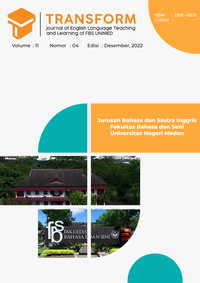Translation Method of English Hymn Song into Indonesian Version in Kidung Jemaat
DOI:
https://doi.org/10.24114/tj.v11i4.44040Keywords:
Translation, Methods, Lyrics, Hymn songAbstract
This study aimed to find out what, how, and why the translation methods became the most dominant in translating English Hymn song in kidung jemaat. This study used a descriptive qualitative approach. The data of this study were 22 songs lyrics by E.L.Pohan. The source of the data was taken from kidung jemaat Hymn song book. The result of this study showed that there are three types of methods used in translating English Hymn song lyrics in to Indonesian language. The most dominant used by the translator is the Adaptation method (68,18%). The adaptation method is the most dominantly used by the translator because it retains the meaning contained in the SL, even though the words are substituted to fit the culture and rythmic calculation of each lyrics word, without altering the original meaning.Downloads
Published
2023-06-05
Issue
Section
Articles
License
Copyright (c) 2023 Lola Purba, Winda Setiasari

This work is licensed under a Creative Commons Attribution-ShareAlike 4.0 International License.
Authors who publish with this journal agree with the following terms:
- Authors retain copyright and grant the journal right of first publication with the work simultaneously licensed under a Creative Commons Attribution License that allows others to share the work with an acknowledgment of the work's authorship and initial publication in this journal.
- Authors are able to enter into separate, additional contractual arrangements for the non-exclusive distribution of the journal's published version of the work (e.g., post it to an institutional repository or publish it in a book), with an acknowledgment of its initial publication in this journal.
- Authors are permitted and encouraged to post their work online (e.g., in institutional repositories or on their website) prior to and during the submission process, as it can lead to productive exchanges, as well as earlier and greater citation of published work (See The Effect of Open Access).
- This work is licensed under a Creative Commons Attribution-ShareAlike 4.0 International License.

This work is licensed under a Creative Commons Attribution-NonCommercial-ShareAlike 4.0 International License.



